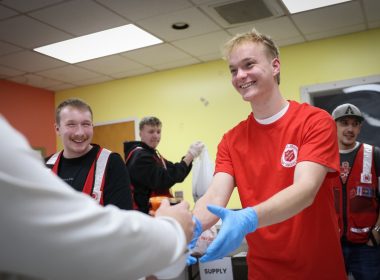The West’s emergency and disaster services director

Whether responding to an earthquake, a fire, a tornado, or any other disaster, John Berglund knows the importance of strategy.
He recently attended a one-week exchange among 27 emergency services personnel and project officers representing all five Salvation Army global zones at a community disaster preparedness conference at the Hong Kong Salvation Army Training College. Conversation focused on the 2016-2030 Global Goals for Sustainable Development set by the United Nations member states, and dealt specifically with the International Strategy for Disaster Reduction, one that promotes a global shift from a culture of reaction to a culture of prevention.
The open exchange of ideas was not unfamiliar to Berglund, who has experience in multi-sector partnerships and government planning and has spent the past 16 years with Salvation Army emergency services. At the conference, he deconstructed his experience and applied its overarching principles to a global context.
“Building local capacity in an overpopulated, over-resourced, culturally diverse metropolis has become a daunting task post-Oklahoma City, Sept. 11, and Hurricane Katrina—all notable milestones in the disaster industry,” Berglund said. “As always, progress is made in small, incremental steps, and relies upon one’s ability to assess the landscape, prioritize action and plan strategically. Anything less is reactionary, and runs the inherent risk of being marginalized on the ground in real time. Disaster risk reduction in a western context is mitigation and preparedness, or in faith-based language, sound stewardship.”
He noted the numerous variables that affect successful delivery of humanitarian aid in catastrophic disasters.
“I’ve come to believe that the most important tool within one’s tool box is faith, the belief that one is being prepared,” Berglund said. “In this highly competitive field, the amount of readily available resources, as well as the number of trained response organizations and spontaneous community based groups, is staggering.”
The Western Territory recruited Berglund in 2002 to create emergency management curriculum and train disaster teams throughout the territory. From 1995-2005, he taught nonprofit management at Arizona State University, which he said prepared him for the role of the national emergency disaster services coordinator at The Salvation Army’s National Headquarters from 2005-2007, during Hurricane Katrina. He then served as the emergency services director for the Greater New York Division from 2007-2015, before moving to the West as its territorial emergency and disaster services director.
Throughout the years, Berglund deployed to assist in numerous overseas disasters, starting with a 2003 deployment to post Ba’athist Iraq to rebuild schools and clinics.
“That experience, the first of many overseas deployments, awakened a passion for international aid and created a curiosity to explore how domestic and international response and recovery mechanisms compare,” he said.
In Hong Kong, Berglund’s final conference exercise was to create a presentation to inform his home territory about the moral imperative to promote global disaster risk reduction. He proposed a three-day earthquake preparedness summit.
“It would be an uninterrupted time to focus on how ‘One Army’ and its partners would respond to and recover from an incident of national significance,” Berglund said. “It is with faith that we take small incremental steps to prepare for tomorrow.”









